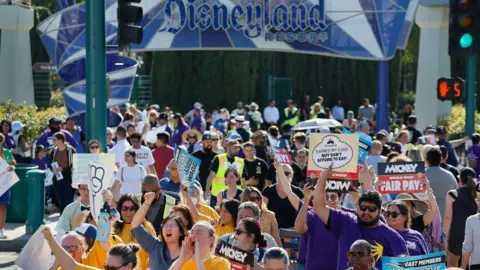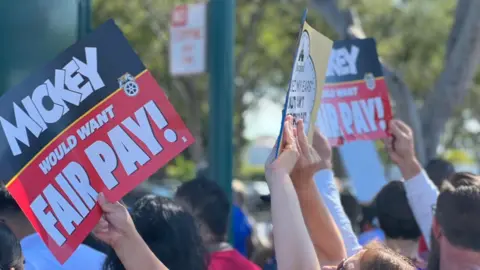By Regan Morris, BBC News, reporting from Anaheim, California
 BBC
BBCCynthia “Cyn” Carranza meticulously searched for a shaded parking spot in the car she considered home.
Disneyland’s night watchman has to sleep during the day, which is tough for anyone, especially when you live in your car with two dogs. Ms Carranza says she earns $20.65 an hour (about £15.99) at the park, but last summer she couldn’t afford rent in the southern California city where the average apartment rent can be more than $2,000 (about £1,550) a month.
Ms. Carranza wept as she recounted the hardships of that summer, including sneaking out to shower in Disneyland’s costume department. She now shares a small apartment with her boyfriend, who also works at the park but barely makes enough to make ends meet.
“It’s not something anyone should have to go through working full-time for a company like Disney,” she told the BBC.
Ms Carranza, like other park employees, described to the BBC the financial hardships of working at what is supposed to be “the happiest place on earth”. About 10,000 unionized workers at Disneyland – the first of 12 parks to be created worldwide – are threatening to strike over wages and what they see as anti-union retaliation.
Hundreds of workers demonstrated outside the park this week, carrying a series of signs and pins showing Mickey Mouse’s gloved fist in defiance.
“Mickey wants a fair wage,” chanted workers outside Disneyland near the park gates.
They voted almost unanimously to authorize the strike on Friday, just days before workers resume contract negotiations.
While the vote doesn’t mean a strike is imminent, it could prompt workers to act quickly if negotiations go sour. The authorization also gives unions leverage as negotiations with Disney management continue next week.
 Getty Images
Getty ImagesThe Disneyland cast members’ contract expired June 16, and ongoing negotiations involve a coalition of unions that represent nearly 10,000 park employees, including everyone from those who work as characters and operate rides to vendors, restaurant workers and janitors.
About one in 10 Disneyland employees have experienced homelessness while working at the park, union officials say. A survey of employees found that 73 percent said they did not earn enough to cover basic expenses each month, and about a third said they had experienced housing insecurity in the past year.
“We’re the ones who create the magic,” says L Slaughter, an entertainer in the Toontown section of the park. “We need Disney to pay us a decent wage.”
Slaughter spent two years living in her car while working at the park. She now lives in a small apartment about an hour’s drive from Disneyland.
She spent a lot of time trying to find a safe parking spot to sleep, she said, adding that staff are not allowed to sleep in Disneyland parking lots.
“My rent just went up $200 and I won’t be able to pay my rent anymore,” she said.
Ms. Slaughter makes $19.90 an hour — thanks to a minimum wage mandate passed by city voters in 2018. Disney has unsuccessfully fought the wage increase, but workers say it’s still not enough to survive in Southern California.
A living wage calculator created by the Massachusetts Institute of Technology, or MIT, says a single person without children would need to be paid $30.48 an hour to live near Disneyland in Orange County, about 30 miles southeast of Los Angeles.
Workers who spoke to the BBC said they kept their jobs at the park because they love the Disney brand and rely on the generous health benefits and union-run food bank, which some workers described as a saving grace.
Disney says it is in negotiations with its “cast members” – the company’s term for employees who play princesses and pirates as well as chefs or janitors who maintain the park.
“We respect and value our cast members and recognize the important role they play in creating happiness for our guests,” Disney said in a statement, adding that negotiations with the unions representing its workers will resume July 22 and that they are committed to reaching an agreement “that focuses on what matters most to our current cast members, helps us attract new cast members and positions Disneyland Resort for growth and more jobs.”
The last strike at Disneyland was in 1984 and lasted 22 days.

Ms. Carranza described the backbreaking work she does every evening at the park: cleaning, polishing, repairing floors and sometimes installing carpets.
She said last summer living in her car was the lowest point of her life, and she credits her dogs for keeping her alive.
“I know it’s because of them that I’m still here, that I haven’t given up,” she said. “There were times when I wondered what I was doing here and how I was going to get back on my feet.”
But even with the small studio apartment Ms. Carranza now has, she says she still lives hand to mouth and can sometimes afford to eat only rice or noodles.
Although the workers’ demands were economic, the strike vote was called in response to complaints that workers had been disciplined for wearing Mickey Mouse badges and handing out union information in the park.
In June, the unions filed an unfair labor practice complaint with the National Labor Relations Board against Disney for “unlawful discipline, intimidation and surveillance of union members exercising their right to wear union badges at work.”

Colleen Palmer, a negotiator for UFCW Local 324, has worked at Disneyland for nearly 37 years and makes about $24 an hour as a merchandise hostess. She said she wore her union badge for less than a half-hour before management told her to take it off.
Palmer says employees are responsible for the experience guests have at Disneyland, and that their loyalty and experience should be rewarded. She said employees believe the pay gap between employees and the company’s executives is outrageous: Disney CEO Bob Iger’s compensation is $31.6 million in 2023, hundreds of times what Disneyland cast members make.
“I wonder why you don’t want to acknowledge me? Because I’m making you this money so you can buy this sports team now,” she said, referring to the news that Mr. Iger and his wife had taken over the Los Angeles women’s soccer team, Angel City Football Club.
The disparity between wages for workers and executives is fueling labor unrest in the United States. According to the left-leaning Economic Policy Institute, CEO pay increased by 1,460% between 1978 and 2021.
Disneyland is a unique place to work. Many consider it a career, not a job, and employees are often fans of the Disney brand as well – some even call it a Disney cult.
Employees enjoy perks like free admission to Disney parks for family and friends. But they also say Disney isn’t flexible when they have a family crisis or get sick. Many have second or third jobs that Disneyland’s unpredictable schedules make it difficult to manage.
For students and retirees working part-time, it may be a dream job, but it no longer provides a living wage for residents of Anaheim and its surrounding areas, a wealthy city whose largest employer is Disney, workers say.
“Without us, Disney would be like any other place,” said Morgan, who lived in motels around Disneyland for four years with his children and wished to be identified only by his middle name.
Morgan’s marriage broke up and he lost his home, and cheap motels were all he could afford on his Disney salary. When his children were with their mother, he often slept outside and hid in the shadows to avoid police or robberies.
He now has a second full-time job as a recruiter – which he can do from home – and an apartment he can afford on his combined income.
Still, he’s proud of his job selling Disney merchandise and says every cast member takes their job seriously.
“It’s not the animatronics’ fault, it’s our fault. At least respect us enough to pay us a decent wage.”



